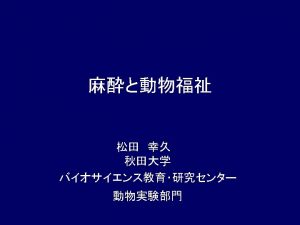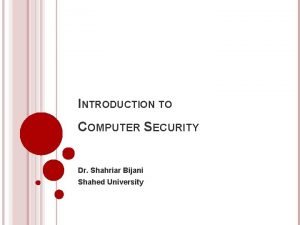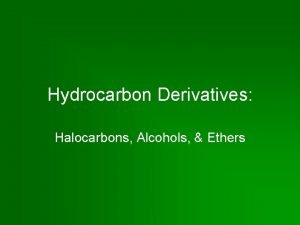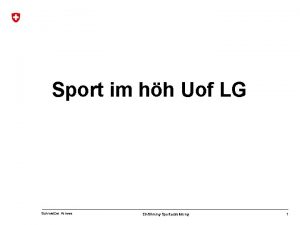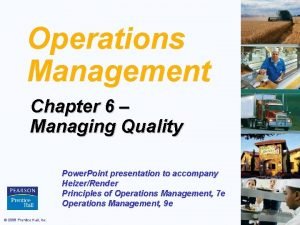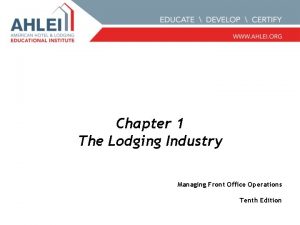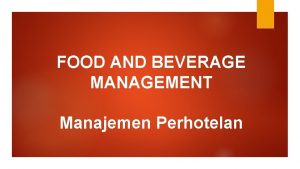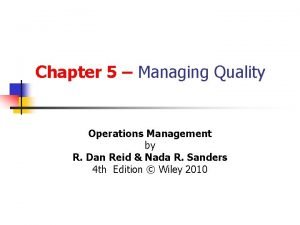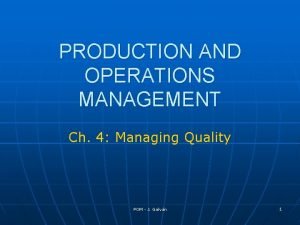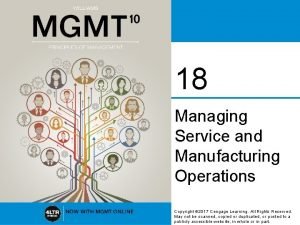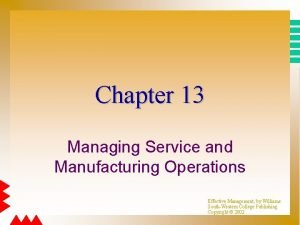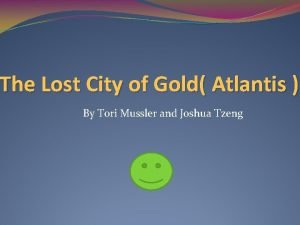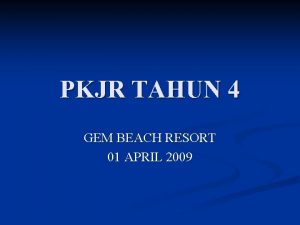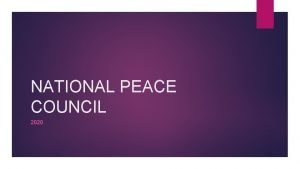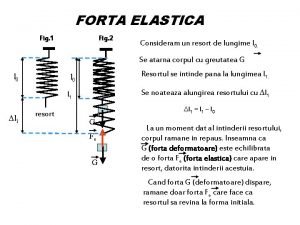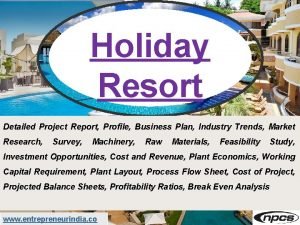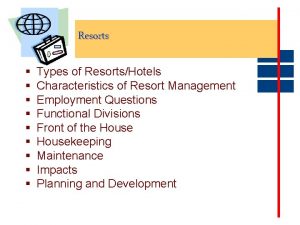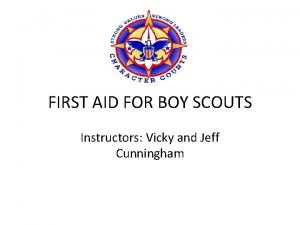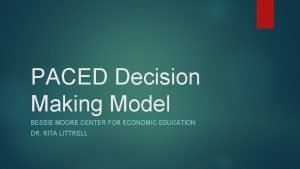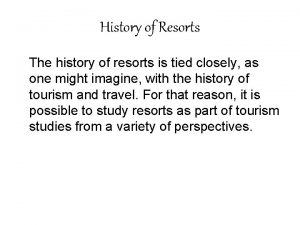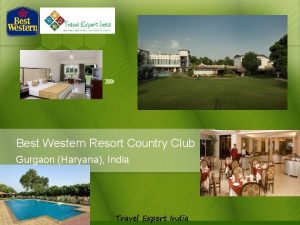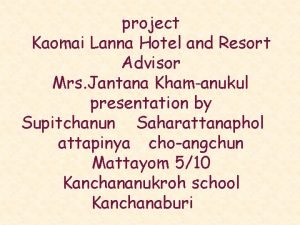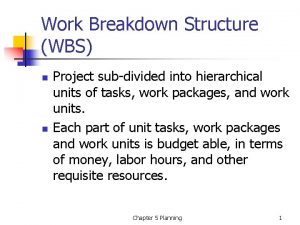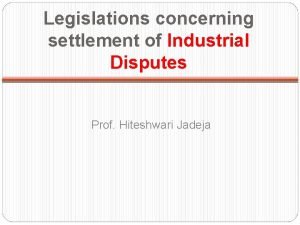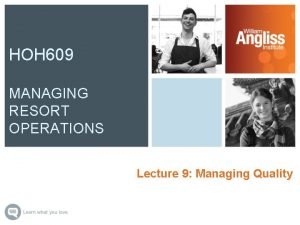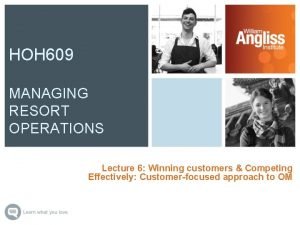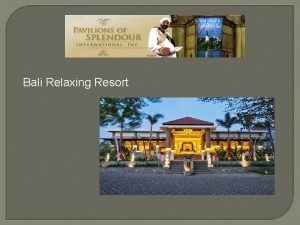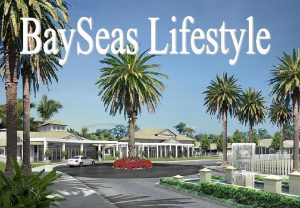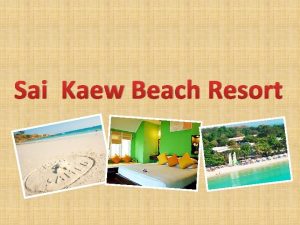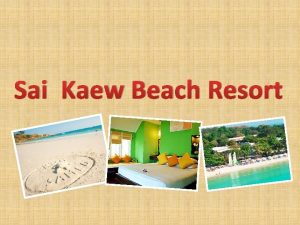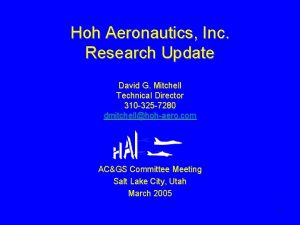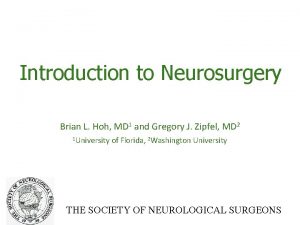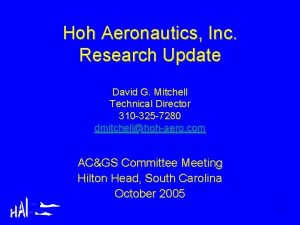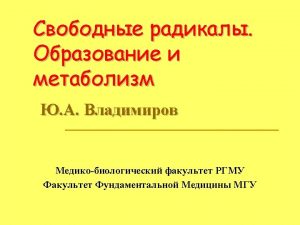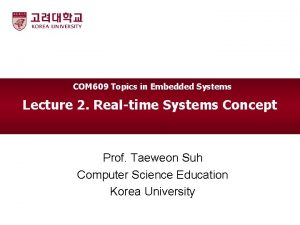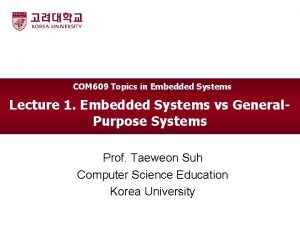HOH 609 MANAGING RESORT OPERATIONS Lecture 8 Managing







































- Slides: 39

HOH 609 MANAGING RESORT OPERATIONS Lecture 8: Managing People & Culture

Industry event – Melbourne 10 October, 2019 WAI Accommodation Association of Australia (AAo. A) http: //www. aaoa. com. au/events/tabid/1885/vw/3/ itemid/492/d/20191010/aaoa-future-melbourneforum-. aspx

Industry event – International Young Hoteliers Summit


Objectives • • • Understand the importance of workplace culture Discuss the key elements supporting/ limiting good workplace culture Explain how HR activities can better support positive workplace cultures

Is your workplace a fun place to work? Do you look forward to spending your day at your workplace? --Does your workplace have difficulties keeping good employees? Do you see/ hear employees whispering in corridors?

What do you like about your workplace? (+) What don’t you like about your workplace? (-)

Associate all the (+) elements with a specific feeling Associate all the (-) elements with a specific feeling

Organisational culture influences employee attitudes & behaviour, either positively or negatively --Managers may know how to create a customer-centric culture, but at the same time may overlook the need of developing good workplace cultures

Organisational culture ‘The way things get done in an organisation through the values, behaviours, and traditions of the employees’ --Culture represents the identity of the organisation and provides ‘organisational meaning’ --Culture is a driver of business performance & growth

Example Source: Hilton Named to 2019 List of Best Workplaces in Canada - 1000+Employees. (2019). Western Hotelier, 43(3), 8.

Example Source: https: //www. houseofdanielthwaites. co. uk/about-us/

Example: The House of Daniel Thwaites (cont. ) • • Brand based on a cultural identity the company engaged its staff to harness their thinking. . . hundreds of team members across the country (UK) were involved in the process, developing a new proposition and bringing the brand to life… as a result, the culture and personality of The House of Daniel Thwaites shines through “We are not a boring, bland, cookie-cutter group giving a very mediocre experience – there are enough of them about in the world… Every one of our hotels and inns is fabulous in its own right”

Business outcomes associated with workplace culture • Employee satisfaction • • Staff turnover • • • Engagement = higher productivity (e. g. , customer service, sales) Effective teams • • Loosing an employee may cost up to twice the employee salary to find, select and train a replacement The cost is higher if a position is harder to fill/ if a good employee leaves Performance • • Positive psychology (e. g. , passion, loyalty) Better employee relationships, cooperation, problem solving Decision making • Managers have more time to make important decisions vs. managing employee behaviour

What is the key driver of good workplace culture?

Good management is the key • • Research shows that good management contributes to better performance outcomes (Sadun, Bloom & Reenen, 2017) Effective performance of basic management tasks can contribute to better quality of processes and also performance, if persistent over time • • • Planning Organising Leading Coordinating & Controlling Competent management is not easy to replicate • e. g. , Human Resource Management strategies and practices

Managing people: operations perspective Resort operational success depends on people: • it depends on how people are fitted into the processes of the organisation: the tasks the employees are given, their level of control over their work, how they are communicated with, how they are treated by the organisation, and their level of satisfaction.

Key managerial considerations Have we designed a job that is ‘doable’…physically, mentally, and emotionally? --Have we communicated to the employees what standard of performance is expected of them? Are our expectations too high? Do we provide good support?

Example: Marriott’s Happiness Culture Living Our Core Values https: //www. youtube. com/watch? v=Vtx 7 h. PWIbjc Marriott’s Happiness Culture is a Family Business https: //www. youtube. com/watch? v=-_v. K-a_Iqjg Revealing Happiness at Marriott's HQ https: //www. youtube. com/watch? v=9 j. Xhl. Cyso. Bs

HRM Process Planning Recruiting Compensation Benefits Selecting Performance Management Orientation Training & Develop ment

The HRM Process Planning q The aim is to ensure effective accomplishment of resort’s vision & mission • Involves attracting, developing & retaining a quality workforce decisions • To ensure that resort remains competitive

HRM Process Recruiting Attracting a qualified pool of job applicants whose abilities & skills meet job specifications Steps in a recruitment process are: • advertising a job vacancy • preliminary contact with candidates • initial screening to identify qualified applicants

HRM Process Selecting Conducting job interviews (procedure): • Plan ahead • Create a good interview climate • Avoid questions that may imply discrimination • Take notes • Keep your notes and records

HRM Process Orientation • Socialisation – • Orientation – • Frames expectations, behaviour and attitudes of new employees. Familiarises new employees with jobs, co-workers and organisational policies and services. Training – Provides learning opportunities to acquire and improve jobrelated skills.

HRM Process Training & Development • • On-the-job training takes place in the work setting while someone is doing a job. Modelling demonstrates through personal behaviour the job performance expected of others

HRM Process Training & Development (cont. ) • • • Coaching an experienced person offering performance advice to a less-experienced person. Mentoring assigns early-career employees as protégés to more senior ones. Off-the-job training outside the work setting.

HRM Process Performance Management Performance management system • Sets standards, assesses results and plans for performance improvements Performance appraisal • Formally evaluating performance and providing feedback to a job holder • Serves two basic purposes: evaluation and development

HRM Process Compensation benefits Retention • A career - jobs & work pursuits • A career path - a sequence of jobs held over time during a career

HRM Process Compensation benefits Work–life balance � Balancing career demands with personal and family needs

Elements that challenge effective people management practices • • • External forces: Demand • Implications: Full-time, part-time & casual mix Internal forces: Supply • Current skills & competencies (all levels) Blind spots (Internal) • False perceptions: managers not able to judge how well their departments are doing • Fear of change: managers might be aware but would not want to change • Workplace politics & culture

Key challenges: Local market conditions affect how managers staff resort departments: • • • Size of the local population Demographic profile (e. g. , number of men and women, age groups…) Skills & expertise of the available workforce Proportion of people employed and unemployed Qualification of the available workforce

Example: Center Parcs All Center Parcs’ resorts are located in forests, away from towns and cities � This presents a challenge to in terms of employing full-time, part-time and casual staff --- Each local area presents different labour market conditions: • • • There are more people living in some areas than others Availability of working labour is below the national average People in different locations have different skills sets – tourism/ non-tourism; training needs would vary from location to location.

Managing people: Local labour market implications From the OM perspective, the external challenges may affect the: • • • Strategies to attract staff Rates of pay to be offered Level & type of training to be offered Strategies to retain quality employees Other incentives to be offered

Key challenges: Emotional labour Process of ‘managing feelings & expressions to fulfill the emotional requirements of a job’ Workers are expected to regulate their emotions during interactions with customers, co-workers and superiors

Key challenges: Rewards � In most organisations, employees receive two types of rewards: Financial Non-financial… Why do you go to work?

HRM: Center Parcs: Judi Leavor Designing Jobs and Managing People https: //www. youtube. com/watch? v=Oi. WSQEp. XDLM

Key points • • • Good workplace culture contributes to better business outcomes Employee-centric & overall effective management practices can contribute to the development of competitive advantage HRM activities can better support positive workplace cultures and business performance

Questions?

Assessment 3: Topic example Service design elements and the key implications � …empower employees to satisfy guest needs and requests � Possible implications: HR selection procedures Comprehensive training programs Incentive program
 Directive 86/609/eec
Directive 86/609/eec Dr shahriar
Dr shahriar Ucc 2 609
Ucc 2 609 Hoh h-c-c-c-h h h
Hoh h-c-c-c-h h h Hoh h
Hoh h Opwekking 609
Opwekking 609 Aw-609
Aw-609 Höh uof lg
Höh uof lg 01:640:244 lecture notes - lecture 15: plat, idah, farad
01:640:244 lecture notes - lecture 15: plat, idah, farad Om 306
Om 306 Chapter 6 managing quality
Chapter 6 managing quality Managing front office operations 10th edition
Managing front office operations 10th edition Food and beverage operation cycle
Food and beverage operation cycle Managing quality in operations management
Managing quality in operations management Managing quality in operations management
Managing quality in operations management Managing service and manufacturing operations
Managing service and manufacturing operations Managing service and manufacturing operations
Managing service and manufacturing operations What is your favourite destination and why
What is your favourite destination and why Atlantis the lost city of gold
Atlantis the lost city of gold Gem beach resort
Gem beach resort Holiday garden hotel & resort chiang mai
Holiday garden hotel & resort chiang mai Peduase valley resort
Peduase valley resort A summer resort rents rowboats to customers
A summer resort rents rowboats to customers Forta elastica are directia
Forta elastica are directia Stone forest golf
Stone forest golf Project report for resort
Project report for resort Characteristics of resort management
Characteristics of resort management Vicky boy resort
Vicky boy resort My favourite holiday destination
My favourite holiday destination Laney todd
Laney todd Radenci spa resort
Radenci spa resort Phygicart registration
Phygicart registration Lmn resort
Lmn resort Nenitas beach resort
Nenitas beach resort History of resort
History of resort Best western resort country club manesar
Best western resort country club manesar Hotle rwanda
Hotle rwanda Wbs travel plan
Wbs travel plan When employees resort to unauthorized strike in violation
When employees resort to unauthorized strike in violation Grand barbados beach resort
Grand barbados beach resort
